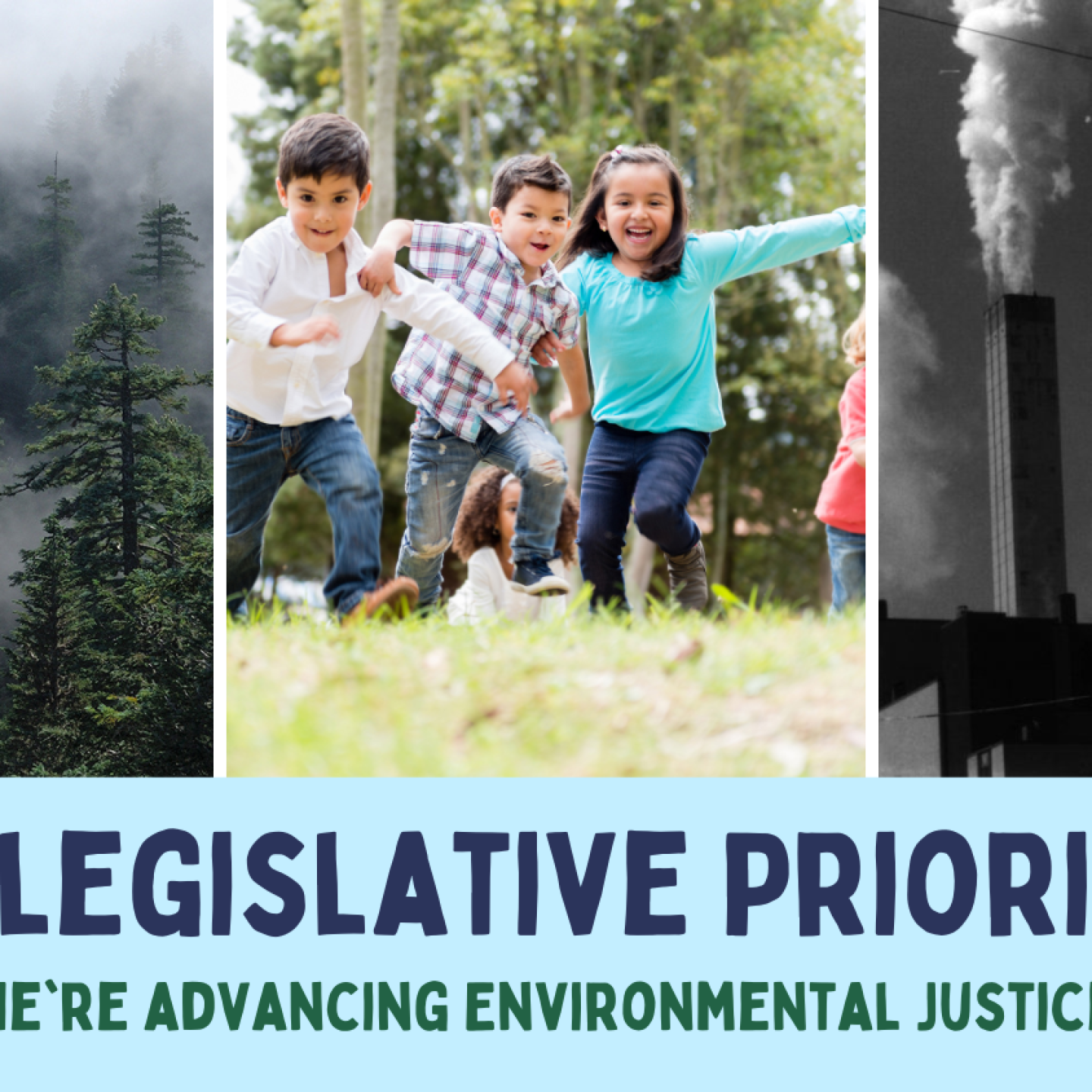This development highlights the power of grassroots action. Oregon’s new law on chlorpyrifos is stronger and more protective than the US EPA.
It’s National Public Health Week. Let’s tackle toxic chemicals!
Every child deserves a safe environment to grow in that allows them to become strong and healthy and develop to their full potential. During National Public Health Week, it's important to draw attention to the health impacts and risks from toxic chemicals in products and the places where children live, learn and play. It is now estimated that 10 million synthetic chemicals are added to the marketplace every year. They range from the chemicals in plastic toys, pesticides on our lawns and school grounds, and harmful additives in our personal care products that go directly onto our skin and are absorbed into our organs.
These chemicals can cause immediate and long-term harm. Toxic chemicals are linked to neurological damage which can leave a child with learning disabilities. Over time, chemicals can lead to a wide range of health problems from endocrine and reproductive disruption to cancer. Exposure to harmful chemicals in consumer products and the environment disproportionately impact communities of color and lower income communities that are more often exposed to cumulative toxins. It is often the case that cheaper and deadlier products are marketed to the most vulnerable members of our communities.
What is Oregon doing to address toxic chemicals?
Thankfully, there are three key bills addressing toxic chemicals this 2023 Session being led by Oregon Environmental Council and Beyond Toxics and their partners. We continue to advocate for and defend these bills from staunch opposition from the chemical and pesticide industry and demand that toxics be prioritized by our lawmakers.
This year, National Public Health Week coincides with an important deadline in Oregon’s legislative session, and thus determines what health-protective policies will, or will not, move forward. On April 4th, every bill currently being considered by the Oregon legislature must have been voted out of its first chamber committee.
What do these bills do, and what is their current status?
1) Toxic Free Schools (SB 426)
Oregon school districts and regulatory agencies currently lack funding, coordination and resources needed to implement safer pesticide use practices. As a result, unintentional yet illegal pesticide uses are occurring at Oregon schools. SB 426 will fix a 14-year unfunded mandate for schools and create a path towards modernized record keeping and safer choices for pest control under the Healthy and Safe Schools Act.
The Toxic Free Schools Act will:
SB 426 was voted out of the Senate Education Committee on March 30th and has been referred to the Joint Ways and Means Committee to address its fiscal impact.
Read more about Toxic Free Schools
2) Toxic Free Cosmetics (SB 546)
People assume personal and beauty products (collectively called “cosmetics”) are safe. But it is estimated there are over 10,000 chemicals in the beauty market today, and account for a $100 billion beauty industry. The Federal Food, Drug and Cosmetics Act (FDCA) has only restricted 11 chemicals since 1938, while the European Union has banned over 1800 chemicals.
Through SB 546, Oregon can require the public disclosure of all chemical ingredients on a company’s product webpage. Doing so is an accessible way for consumers to make educated purchasing decisions. Additionally, it will ban the sale of the worst chemicals in cosmetics and personal care products like many other states have.
SB 546 passed out of the Senate Energy and Environment Committee on March 28th, unanimously and bipartisan, and has been referred to the Joint Ways and Means Committee to address its fiscal impact.
Read more about Toxic Free Cosmetics.

Photo courtesy of Tanaphong Toochinda
3) Toxic Free Kids Modernization Act (HB 3043)
Thousands of chemicals lurk in products our kids use every day, and children are far more vulnerable to toxic chemicals than adults. HB 3043 builds on the success of Oregon’s 2015 Toxic Free Kids Act by strengthening protections for children’s health and streamlining business reporting requirements.
A modernized Toxic Free Kids Act will:
HB 3043 passed out of the House Committee on Climate and Energy on March 15th, also unanimously and bipartisan, and subsequently passed the full House 42-14 also on a bipartisan vote, on March 22nd. It heads to the Senate Energy and Environment Committee as its second chamber.
What Can you do?
In your day-to-day life, keep in mind ways that you can buy toxics-free or organic items to reduce your risk of chemical and pesticide exposure. When possible, consider reducing your use of cosmetics or products if you’re sensitive to chemicals. Be sure to wash hands and remove your shoes after playing on school fields.
In addition, contact legislators and urge them to act NOW to regulate toxic chemicals and protect public health for Oregonians. Let them know we are depending on them to help keep our families safe from harmful chemicals and pesticides at home and at school.
Authors:
Jamie Pang, Environmental Health Program Director, Oregon Environmental Council
Lisa Arkin, Executive Director, Beyond Toxics
Advancing Environmental Justice in 2023
Our 2023 Legislative Priorities
I am thrilled to report that we are gearing up for another very exciting year of advocacy and activism! Each year Beyond Toxics creates a list of priorities for the Oregon legislative session, working with our members and community partners to support strong public and environmental health policies for the state.
Our advocacy campaigns are rooted in environmental justice, putting equity and inclusion in all sectors of Oregon policy-making at the center of our work. I believe that, in order to build a thriving and just Oregon, we need to urge local legislators to vote in favor of strong and equitable policies that demonstrate an ongoing commitment to environmental stewardship and the advancement of human rights and dignity.
We are leading three priority initiatives during the 2023 Oregon legislative session. The issues addressed reflect areas of concern for frontline communities bearing the brunt of climate change and environmental degradation. Our team remains a steadfast advocate for all Oregonians, especially those living in underserved communities across the state.
These are our three legislative priorities for the 2023 session:
Natural Climate Solutions (SB 530)
Creating Natural Climate Solutions
We are working with a statewide coalition to put forward the Natural Climate Solutions bill, SB 530. This could be a game-changer for climate action in Oregon! SB 530 is a comprehensive bill that will help the state achieve its climate goals, support Oregon’s environmental justice communities and small landowners, improve equitable outcomes in the face of climate change, and protect our state’s vital natural resources.
If passed, SB 530 will…
In addition to all these climate benefits, implementing this bill will result in significant and measurable environmental benefits of cleaner air, healthier soils and protected drinking water.
“This ambitious piece of legislation prioritizes activities that protect or improve the ability of Oregon’s natural and working lands to sequester carbon. This is the necessary climate action our state needs and, if it is successful, it will put an amazing framework in place to address greenhouse gas reduction in our forests, agricultural lands, and rangelands.” ~ Teryn Yazdani, Staff Attorney and Climate Policy Manager
Read more about the Natural Climate Solutions bill
Toxic Free Schools (SB 426)
Pesticide Reduction and Improved Management Practices For Schools
Our second legislative priority is The Toxic Free Schools bill, SB 426, which is part of a three bill suite of environmental health bills lined up to protect children's health from exposure to toxic chemicals. The goal of SB 426 is to improve transparency around pesticide use in Oregon schools and provide funding to support schools integrated pest management planning. When Oregon's School Integrated Pest Management law was enacted in 2009, it did not allocate funding to the Department of Education or school districts to implement the law. As a result, many hazardous and unlawful pesticide applications have occurred on Oregon’s school campuses in the last thirteen years.
If SB 426 is passed, a proactive approach to adopting the safest pest management methods will ensure school children are not exposed to pesticides that can cause cancer and other negative health impacts.
If passed, SB 426 bill will…
“Ultimately, the Toxic Free Schools bill will provide resources to the Department of Education to support school districts in updating and implementing IPM plans and improve transparency under Healthy and Safe schools. The goal is to prevent children's exposure to pesticides on athletic fields, playgrounds, cafeterias and learning spaces.” ~ Jennifer Eisele, Pesticide Policy Manager
Read more about the Toxic Free Schools bill
Oregon's Medical Waste Incineration Act (SB 488)
Covanta waste incinerator, Chester, PA. Image courtesy of Chester Residents Concerned for Quality Living.
Air Quality Solutions
The third bill we are prioritizing is Oregon's Medical Waste Incineration Act, SB 488. This bill will close a regulatory loophole in Oregon’s air quality laws that allows a municipal waste (trash) incinerator to burn large amounts of medical and industrial waste, including waste trucked in from out-of-state. Each year, Oregon’s municipal waste incinerator burns more than 176,000 tons of municipal, medical and industrial waste. In recent years, this incinerator has steadily increased their tons of out-of-state hospital and medical waste every year! Burning medical waste, which is often plastics such as PVC, is known to emit more toxic pollutants than most municipal waste due to the complex nature of medical waste. As medical waste incineration increases, emissions of dioxin compounds and other dangerous chemicals also increase. Dioxin is a highly hazardous toxin linked to cancer and reproductive problems. Currently, the incinerator is regulated under the relatively lax rules despite burning a large percentage of out-of-state medical waste. Oregon can close loopholes in the law that will reduce emissions from waste incinerators. The large amounts of air toxics emitted from its stack has impacted human and environmental health around Marion county for over 30 years.
Now is the time to pass SB 488 to implement a much-needed update to Oregon clean air laws. Oregon must adopt stricter emission limits for incinerators burning large amounts of medical waste incineration. The result will be improved air quality for communities around waste incinerators now and into the future.
If passed, SB 488 will…
“In essence, Covanta Marion is a medical waste incinerator masquerading as a municipal waste incinerator by taking advantage of this loophole. Covanta Marion essentially doubles its profits by importing medical waste from out of state. The fact that Covanta Marion can burn medical waste and pollute while taking advantage of weak environmental regulations makes Oregon a dumping ground for the toxic pollution that other states don’t allow.” ~ Lisa Arkin, Executive Director
Read more about Oregon's Medical Waste Incineration Act
What To Expect
The Beyond Toxics team will fight to pass all three bills during the 2023 legislative session. Our goal is to keep advancing stronger policies that implement meaningful change for Oregon’s environmental policies and prioritize human and environmental health.
However, we do not work alone! We rely on support from local communities and people that are concerned about environmental and public health issues. You can help us get these bills passed this session!
Here’s how you can get involved right now…
Krystal Abrams, Communications Manager
Oregon Department of Forestry’s “Social License” for Aerial Spray Has Expired
Photo of Nehalem Bay, Oregon (above) by Don Best
Beyond Toxics continues to stand up for Oregon’s forests, watersheds, and communities. Keep reading to see how we’re moving the mark on pesticide use in Oregon’s state forest lands.
Tank Mixes on State Forest Lands
At the September 8, 2021, Board of Forestry meeting, we presented findings to the Board summarizing herbicide applications on Oregon State Forests from January 1, 2020, to August 30, 2021. Bottom line: in that brief 20-month period, 326 tank mixes were applied to state-managed forest lands, over a third of which were aerial sprays. Check out our first report here.
Nehalem Watershed Case Study
For the November 3, 2021, Board of Forestry meeting, we presented a case study of herbicide impacts in the Nehalem Watershed. We sent the Board a set of maps we created using data obtained from FERNS depicting pesticide applications in the Nehalem Watershed from 2015-2021, including Astoria, Tillamook, and Forest Grove Districts.
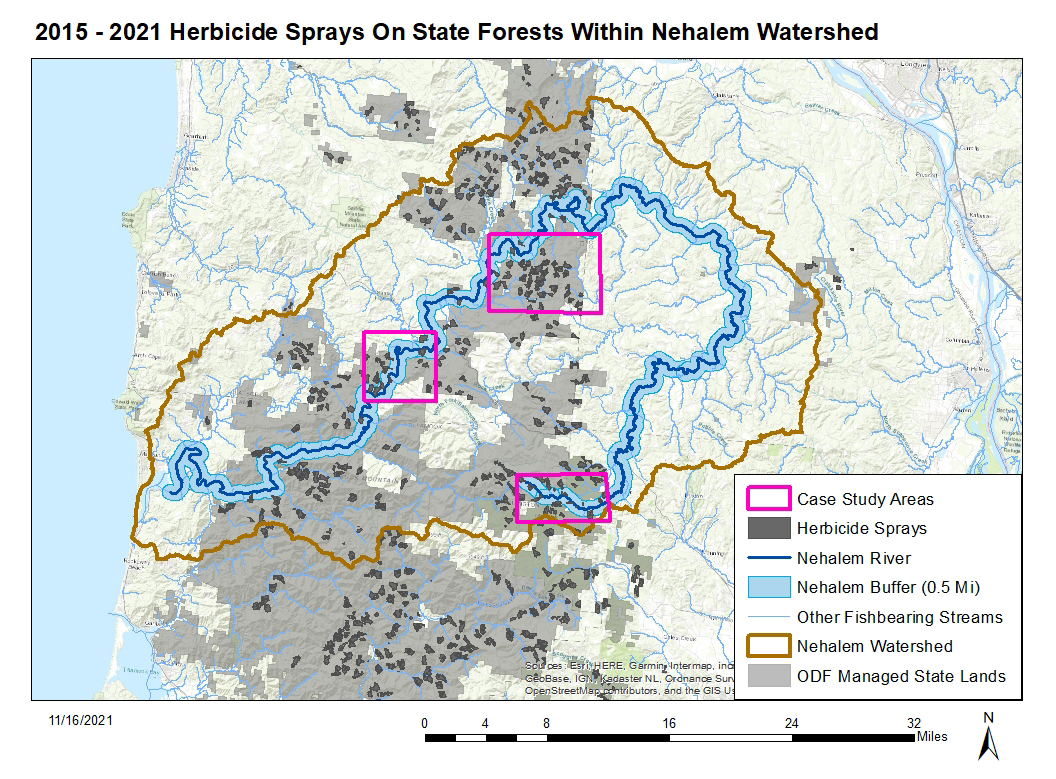
Map 1. The Nehalem Watershed
The maps that follow take a deeper look at a few “Case Study Areas” outlined in pink. Our goal was to use this case study focused on the headwaters and other stretches of the Nehalem River to help the the Oregon Department of Forestry and the public visualize where pesticide sprays take place, note their close proximity to important fish-bearing streams, and consider related impacts on Oregon’s iconic salmon and trout populations.
Case Study 1: Headwaters of the Nehalem River
This map shows herbicide applications at the headwaters of the Nehalem River. There were 52 acres sprayed within a 500 foot radius of the river, many of which were adjacent to perennial streams that form the Nehalem River headwaters.
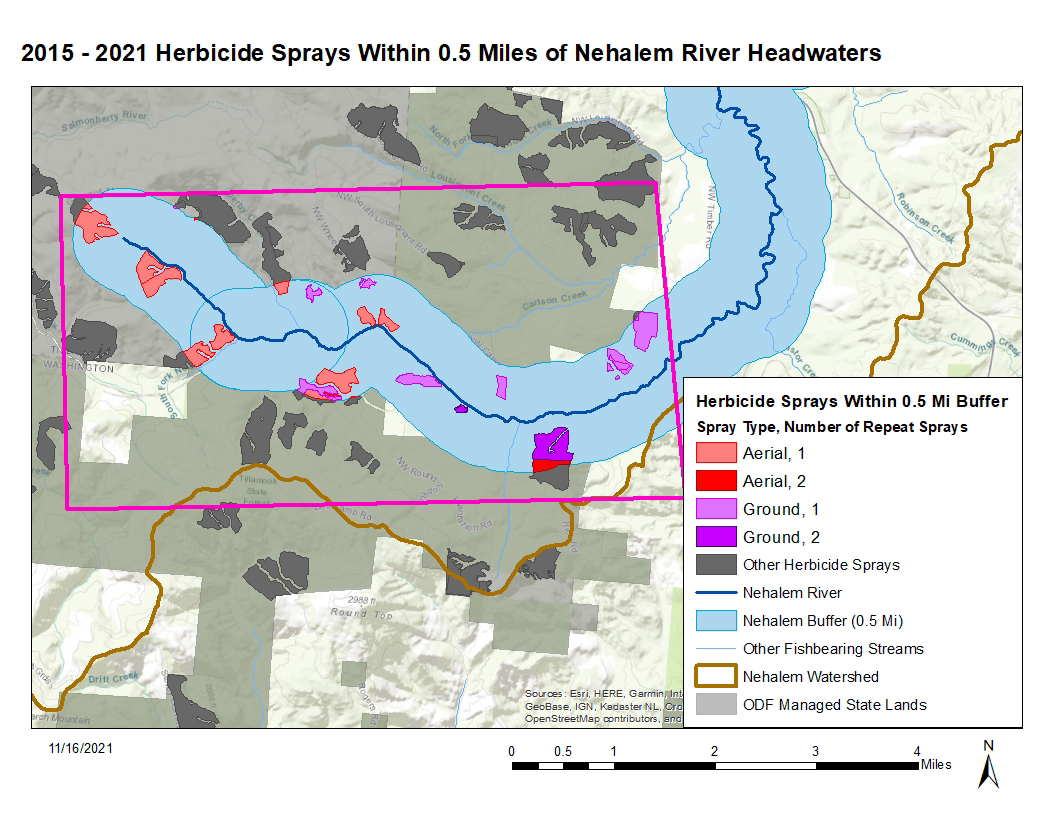

Case Study 2: Lower Third of the Nehalem River
This next map shows part of the lower third of the Nehalem River, which includes the Astoria District. There were 95 acres sprayed within a 500 foot radius of the river. More than two-thirds of sprays closeby were aerial sprays.
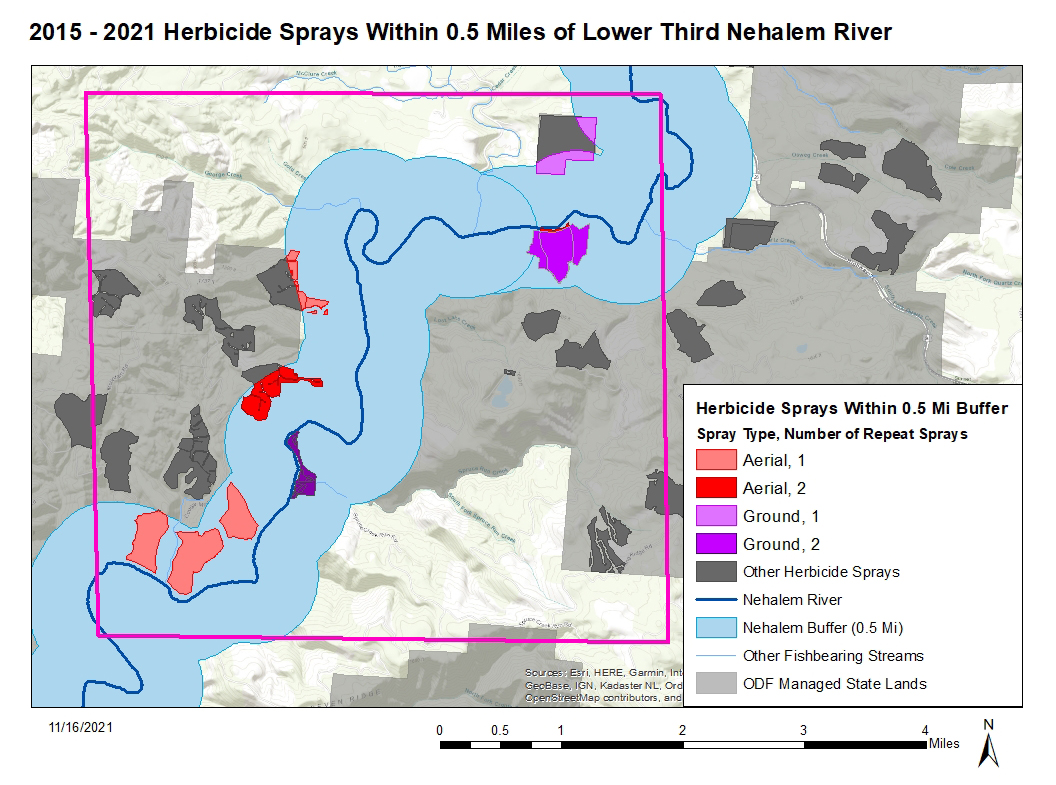

Case Study 3: Perennial Streams
ODF requires a no-spray buffer on perennial streams, so the map for Case Study 3 accounts for a 100 foot no-spray buffer. It must be noted that, despite no-spray buffers, chemicals applied may unintentionally enter waterways--especially in the case of aerial applications. A number of factors including weather and site conditions can cause aerially-applied pesticides to drift into unintended areas, including nearby streams. As shown, the overwhelming majority of sprays touching this 100 foot buffer were aerial sprays.
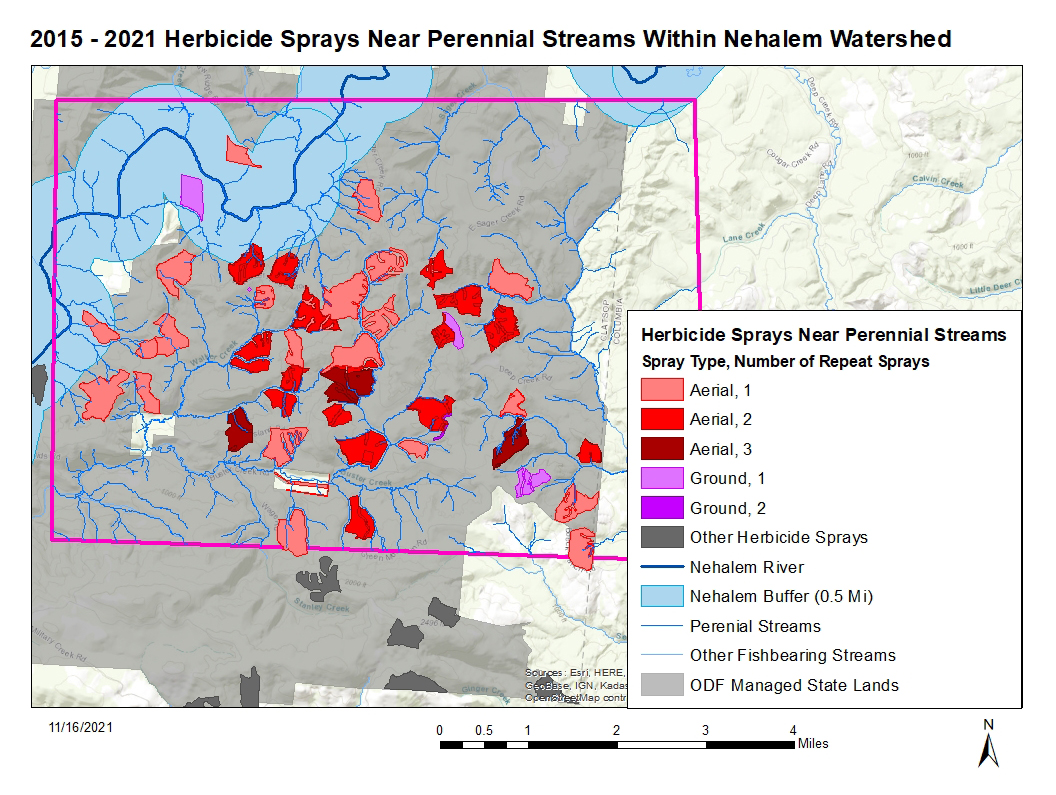

Pesticides and Fish
As shown above, herbicide sprays of chemical tank mixes are occurring throughout the length of the Nehalem River. The Department of Forestry's spray activity starts in the highest reaches of the perennial streams that form the headwaters of the watershed, which may result in a pattern of cumulative residues in the waters and soils of critical aquatic wildlife habitat. Once in the streams, pesticides can affect fish including salmon in many different ways, including by hindering the olfactory system of juvenile salmon, reducing the ability of juvenile salmon to adapt to saline environments, or disrupting swimming and predator avoidance. And in addition to the known effects of single chemicals, tank mixes of pesticides that are used often have not been tested in their combined state so their true toxicity on fish and aquatic organisms remains unknown.
The Nehalem River is the largest “wild fish only” river on the Oregon Coast and home to several runs of salmon, including one of the healthiest runs of Oregon Coast coho. Oregon Coast coho are a federally threatened species of salmon that have key spawning habitat in this basin. Based on the data we have compiled using the FERNS system, the large majority of the Department’s pesticide sprays in the area take place in the summer, so steelhead juveniles will be hit hard because that is when they emerge. Summer Chinook spawn right at the end of the peak spray season, so their egg development may be affected as well. The biggest effects will be on Oregon Coast coho, cutthroat trout, and steelhead, all of which spend one to two years in the Nehalem as juveniles and will thus be exposed to these toxins for longer than other species that migrate downstream immediately, such as chum salmon.
Pesticides and Climate Change
Finally, we cannot ignore the connection between pesticide use and climate change.
The Pacific Northwest has warmed by about 3 degrees F (or 1.7 degrees C) in the past half-century. Higher temperatures create imbalances in natural systems, causing more outbreaks and damage from pests and invasive weeds. This leads to increased reliance on pesticide use as there are more pests to manage. However, pesticides contribute to the climate crisis throughout their manufacture, transport and application.
While all communities deserve protected, clean drinking water, pesticide use has put dwindling drinking water sources at risk. Warming waters may increase pesticide toxicity, making matters worse for climate-stressed fish and other aquatic life. Additionally, studies show pesticides kill over 70% of the microbial diversity in soils. Mature and old growth trees, diverse vegetation, and healthy soils are needed to maximize the carbon sequestration potential of our forests.
Further, as pollinator populations are declining due to climate change, pesticide use causes additional stress. Recent research indicates high bee abundance and diversity in PNW forests. However, pesticide use can degrade pollinator habitat, particularly for ground nesting native bees. Exposure to heavily-used glyphosate can harm the development of a pollinator’s gut microbiome, lowering lifespans and decreasing their ability to withstand pathogens.
Why Does Our Data Matter?
It is crucial that ODF manage state forest lands to support resilient, climate-adapted forests that can withstand disturbances and changing conditions. Board Chair Kelly even called chemical spray “an issue of social license” and we agree; following years of toxic pesticide release that has threatened drinking water and important fish and wildlife habitat, the social license for aerial spray has long since expired. Thus, we will keep asking that the Board place a moratorium on aerial herbicide sprays and initiate an evaluation of the full range of impacts of herbicide sprays--particularly aerial herbicide applications--on state-managed forest lands on drinking water quality, greenhouse gas emissions, essential fish habitat, and community health and wellbeing. Onward!
Read our testimony to the Board of Forestry for more details and sources (PDF).
Learn more about all our efforts to advance Resilient Forestry
~ Grace Brahler, Oregon Climate Action Plan & Policy Manager
Winning the Battle to Ban Chlorpyrifos!
In 2020, Oregon became the 4th state to phase-out the organophosphate insecticide, chlorpyrifos. This law came about as a result of a 2-year legislative campaign led by Beyond Toxics to ban the use of chlorpyrifos. We fought for a complete ban, and we knew a phase-out was not enough.
Today we celebrate the EPA’s August 18th decision to END the use of chlorpyrifos on all food crops, a ban that will also apply to Oregon.




